
How to Monetize Your Content
In this article, we will explore how creators can monetize their content online and best practices to make monetization successful.
A sponsored post is any type of post that you spend money on to help you reach a wider audience.
A sponsored post is any type of post that you’ve put money behind to help you reach a wider audience. As organic reach on social media continues to fall, businesses have started to invest more of their budget in sponsored posts.
The post could be an image, a video, a carousel, or even just text, depending on the social media platform you’re sponsoring on.
When people refer to sponsored posts, they’re referring to one of the following two types:

You can find sponsored posts on any of the major social media platforms: Instagram, Facebook, LinkedIn, TikTok, YouTube, Twitter, Google Business Profile, and Pinterest. You’ll know when you run into a sponsored post because they will be clearly labeled to comply with advertising regulations.
You can identify whether a post is a sponsored post because it will have a ‘Sponsored’ label right below the account name in the post and have a “Sign up” or “Learn more” CTA button.
If it’s a sponsored post through an influencer partnership, it’s usually indicated with a #ad, #sponsored, or #partner hashtag in the post caption and with a “paid partnership with [brand name]” tag that comes immediately after the user name.
Sponsored posts, as in influencer branded content, are created by partnering with an influencer within your niche or industry and, thus, share a similar audience to yours. Finding the right partner is key because you don’t want the post to look inauthentic.
Keep in mind you don’t need to work with an influencer who has millions of followers. Find micro-influencers, or anyone on social media with a niche and highly engaged following, to hype your brand. In the end, the perfect type of partnership is one where the influencer genuinely believes in the brand’s mission and would use the products or services regardless of the sponsored post.
Typically, the brand and influencer will negotiate the terms of the sponsored post, such as the compensation, the number of pieces of content, the type of content, the main message, etc. Once the agreement has been made, you can focus on collaborating with them to develop the content for the sponsored post. The most important thing is to allow them to use their own creativity and personality to create the content, especially because they know their audience best and know what works and what doesn’t. For more tips on collaborating with micro-influencers, check out our influencer marketing guide.
The first step to ensuring you create a successful sponsored post campaign is to set your goals and the metrics you’ll use to measure success. Your goals will affect which influencers you work with and how you collaborate with them, while your selected metrics will help you assess the success of your campaign at the end of it.
Here are some possible goals and metrics you could consider:
Once you have selected your metrics, record the current stats just before the start of your campaign, so that you can compare them with the stats at the end of your campaign.

In this article, we will explore how creators can monetize their content online and best practices to make monetization successful.

Here's how content creator Toni Bravo landed over 100 brand deals and has created a full time career out of social media.

Micro-influencers can help businesses reach more people and attract potential customers. Here's a complete micro-influencer marketing guide to help you.